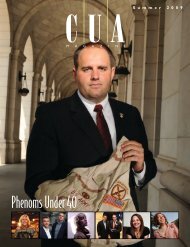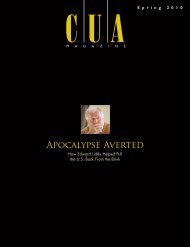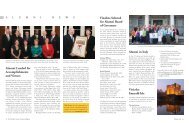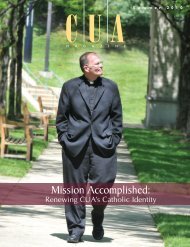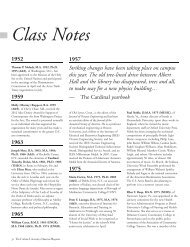“It's Our Time!” - CUA Magazine - the Catholic University of America
“It's Our Time!” - CUA Magazine - the Catholic University of America
“It's Our Time!” - CUA Magazine - the Catholic University of America
You also want an ePaper? Increase the reach of your titles
YUMPU automatically turns print PDFs into web optimized ePapers that Google loves.
“It’s <strong>Our</strong> <strong>Time</strong>!<strong>”</strong><br />
The Era <strong>of</strong> Girl Power<br />
By Lisa Carroll<br />
More than 200 women participate in<br />
intercollegiate athletics at <strong>CUA</strong>. They may not<br />
have experienced <strong>the</strong> inequities for female<br />
athletes before <strong>the</strong> passage <strong>of</strong> Title IX in 1972,<br />
but <strong>the</strong>y are forever shaped by <strong>the</strong> landmark<br />
legislation.<br />
On an early November Sunday, <strong>Catholic</strong> <strong>University</strong>’s field hockey team takes <strong>the</strong> field<br />
for <strong>the</strong> second time in two days. It’s slightly warmer than <strong>the</strong> previous day’s blustery<br />
game, when <strong>the</strong> Cardinals defeated Susquehanna <strong>University</strong>. Bundled up fans seek out<br />
sun-soaked spots in <strong>the</strong> bleachers, at least until <strong>the</strong>ir source <strong>of</strong> warmth begins to dip behind<br />
Cardinal Stadium.<br />
On <strong>the</strong> field, <strong>the</strong> young women run warm-up drills. They seem not to notice <strong>the</strong> chilly<br />
wea<strong>the</strong>r. On this day, <strong>the</strong>y are focused on playing Drew <strong>University</strong> for <strong>the</strong>ir second consecutive<br />
Landmark Conference championship. The team forms a circle in <strong>the</strong> middle <strong>of</strong> <strong>the</strong> field and<br />
taps <strong>the</strong>ir sticks.<br />
“It’s our time!<strong>”</strong> <strong>the</strong>y yell.<br />
Once <strong>the</strong> game is under way, spectators stomp <strong>the</strong>ir feet and rattle <strong>the</strong> bleachers. A group <strong>of</strong><br />
male students, passing up NFL football to be at <strong>the</strong> game, chant “Let’s go, Cards!<strong>”</strong><br />
After a hard-fought first half, <strong>the</strong> game is tied 1-1.<br />
In <strong>the</strong> second half, <strong>the</strong> team scores two goals within five minutes. That will be enough for<br />
<strong>CUA</strong>. As <strong>the</strong> last seconds tick <strong>of</strong>f <strong>the</strong> clock, fans stand and clap, calling out <strong>the</strong> names <strong>of</strong> friends<br />
and family members on <strong>the</strong> field. The players run to midfield, celebrating a 3-2 win with hugs,<br />
leaps into each o<strong>the</strong>r’s arms, championship T-shirts, and a brand-new trophy.<br />
The road to this championship may have begun 40 years ago.<br />
Senior Ca<strong>the</strong>rine Mirsky celebrates with her field hockey teammates<br />
after winning <strong>the</strong> conference championship in November.<br />
14 The <strong>Catholic</strong> <strong>University</strong> <strong>of</strong> <strong>America</strong> <strong>Magazine</strong><br />
Spring 2013 15
Senior Jill Woerner and her team finished <strong>the</strong> regular season<br />
24-1, were ranked 10th nationally, and won <strong>the</strong> Landmark<br />
Conference championship.<br />
Title IX is a Game-Changer<br />
Approximately 215 women are participating in <strong>CUA</strong><br />
intercollegiate athletics during <strong>the</strong> 2012–2013 academic year.<br />
Since fall 2011, women’s teams have won six Landmark<br />
Conference championships. The women’s basketball, field<br />
hockey, and lacrosse teams have made appearances in NCAA<br />
Division III national tournaments.<br />
When women on <strong>the</strong>se teams were born, Title IX had been in<br />
place for about 20 years. Passed by Congress in 1972, Title IX<br />
states that any school receiving government money cannot treat<br />
females and males differently because <strong>of</strong> <strong>the</strong>ir sex. Academic<br />
opportunities and organized sports for girls and young women<br />
expanded. During <strong>the</strong> 1971–1972 academic year, 29,977<br />
women participated in college sports, according to <strong>the</strong> book Let<br />
Me Play: The Story <strong>of</strong> Title IX. Last academic year, <strong>the</strong>re were<br />
195,657, according to <strong>the</strong> NCAA.<br />
Women on current <strong>CUA</strong> rosters grew up balancing academics<br />
and practices for sports, a variety <strong>of</strong> which were available to<br />
<strong>the</strong>m. Unlike some generations before <strong>the</strong>m, <strong>the</strong>y had opportunities<br />
to attend summer sports camps and development programs.<br />
They played on traveling club teams and for <strong>the</strong>ir high schools.<br />
To <strong>the</strong>m, being feminine never meant you couldn’t also play<br />
sports.<br />
“This generation has grown up with WNBA games on TV.<br />
That was something I had never seen as a kid,<strong>”</strong> says Gia Cillizza,<br />
head field hockey coach, who played field hockey at Division I<br />
Miami <strong>University</strong> <strong>of</strong> Ohio in <strong>the</strong> late 1990s. “The girls today<br />
have such an easy entree to athletics. They have pink shorts and<br />
pink and green lacrosse and field hockey sticks. I wore George<br />
Brett spikes and an Ozzie Smith glove for s<strong>of</strong>tball. These girls<br />
know Jennie Finch, Diana Turasi, and Serena Williams, and<br />
have grown up in a time where you could put a bow in your hair<br />
and still be a beast on <strong>the</strong> field.<strong>”</strong><br />
Today, women’s sports programs can be found in almost every<br />
high school and college athletic program. Because <strong>of</strong> that,<br />
Meghan McDonogh, head women’s lacrosse coach, says that she<br />
thinks <strong>the</strong> importance <strong>of</strong> Title IX has been lost somewhat on <strong>the</strong><br />
current generation <strong>of</strong> female athletes.<br />
“Hands down, I wouldn’t be where I am without Title IX,<strong>”</strong><br />
explains McDonogh, who holds a doctorate in sport<br />
administration. “It’s important for <strong>the</strong>se girls to respect <strong>the</strong> past.<br />
If you don’t know what happened in <strong>the</strong> past, how can you<br />
continue into <strong>the</strong> future?<strong>”</strong><br />
The Dawn <strong>of</strong> Women’s Athletics at <strong>CUA</strong><br />
In 1961, at <strong>the</strong> age <strong>of</strong> 22, Jone Dowd came to <strong>Catholic</strong> <strong>University</strong>’s<br />
athletics department as its first full-time female employee to set<br />
up physical education and intramural programs for women. She<br />
had just earned a bachelor’s degree in physical education at<br />
Sou<strong>the</strong>rn Connecticut State <strong>University</strong>.<br />
Dowd taught <strong>CUA</strong> freshman and sophomore women, who at<br />
that time were required to take physical education. She set up a<br />
women’s intramural sports program, which<br />
<strong>of</strong>ten featured sororities competing against each<br />
o<strong>the</strong>r.<br />
In 1961, during a meeting <strong>of</strong> women<br />
athletic administrators from local universities,<br />
<strong>the</strong> group proposed setting up competitions<br />
among <strong>the</strong> universities’ respective female<br />
athletes. The intercollegiate program eventually<br />
grew into <strong>the</strong> Metropolitan Intercollegiate<br />
Sports Association for Women.<br />
“We took <strong>the</strong> best players from each<br />
sorority team as well as <strong>the</strong> best physical<br />
education students and asked <strong>the</strong>m if <strong>the</strong>y<br />
would like to join a varsity extramural team,<strong>”</strong><br />
she explains. Beginning in <strong>the</strong> 1960s and<br />
early 1970s, <strong>the</strong> <strong>University</strong> fielded extramural<br />
teams in field hockey, volleyball, basketball,<br />
swimming, and tennis.<br />
There wasn’t a lot <strong>of</strong> funding for <strong>the</strong>se<br />
early teams, almost all <strong>of</strong> which were coached<br />
by Dowd. She would drive teams to games in<br />
her nine-person station wagon. The <strong>University</strong><br />
supplied a dozen red tunics as uniforms<br />
that were shared by almost every female<br />
sports team.<br />
Although Dowd had <strong>of</strong>ten been frustrated<br />
by a lack <strong>of</strong> interest from women in sports<br />
participation, she says that changed after<br />
Title IX. More women came to <strong>the</strong><br />
<strong>University</strong> with athletic experience in high<br />
school and an interest in competing on <strong>the</strong><br />
college level.<br />
Dowd retired in 2008 after 47 years at <strong>the</strong><br />
<strong>University</strong>, 34 <strong>of</strong> <strong>the</strong>m as head women’s<br />
tennis coach. She witnessed many changes in<br />
women’s sports during that time: <strong>the</strong> eventual<br />
hiring <strong>of</strong> coaches for women’s extramural<br />
teams, <strong>the</strong> passage <strong>of</strong> Title IX, <strong>the</strong> NCAA’s<br />
decision to administer women’s sports in<br />
1981, <strong>the</strong> expansion <strong>of</strong> women’s sports at<br />
<strong>CUA</strong>, and a shift in cultural attitudes toward<br />
women’s participation in athletics.<br />
“When female former students come to<br />
me and introduce <strong>the</strong>mselves as having been<br />
on a sports team, <strong>the</strong>y <strong>of</strong>ten say those were<br />
<strong>the</strong> best years <strong>of</strong> <strong>the</strong>ir lives,<strong>”</strong> she explains.<br />
“That’s very rewarding to hear.<strong>”</strong><br />
Sharon Hodges Repass (B.S.N. 1981) got<br />
her start in basketball in <strong>Catholic</strong> Youth<br />
Organization leagues. At <strong>the</strong> Academy <strong>of</strong> <strong>the</strong><br />
Holy Cross in Kensington, Md., Repass<br />
played on a team that put toge<strong>the</strong>r a winning<br />
streak that lasted several years. Many <strong>of</strong> her<br />
teammates earned scholarships to play at <strong>the</strong><br />
college level. She came to play at <strong>CUA</strong> in<br />
1977, not long after <strong>the</strong> passage <strong>of</strong> Title IX.<br />
Repass received a full athletic scholarship<br />
and was a four-year starter for <strong>the</strong> Cardinals.<br />
At that time, <strong>the</strong> <strong>University</strong> <strong>of</strong>fered athletic<br />
scholarships. She was also <strong>the</strong> first woman at<br />
<strong>the</strong> school to score 1,000 career points and is<br />
<strong>the</strong> all-time leading rebounder. She was <strong>the</strong><br />
first woman inducted into <strong>CUA</strong>’s Hall <strong>of</strong><br />
Fame, <strong>of</strong> which her great-grandfa<strong>the</strong>r,<br />
grandfa<strong>the</strong>r, and great-uncle are members.<br />
Her daughter Michele was named <strong>CUA</strong>’s<br />
first-ever Capitol Athletic Conference Field<br />
Hockey Rookie <strong>of</strong> <strong>the</strong> Year.<br />
Of her time at <strong>the</strong> <strong>University</strong>, Repass<br />
recalls, “We made friends from o<strong>the</strong>r <strong>CUA</strong><br />
sports teams and <strong>the</strong>y would come watch our<br />
games and we would watch <strong>the</strong>irs. The<br />
campus was very supportive <strong>of</strong> girls’ sports.<strong>”</strong><br />
During her senior year, Repass’ coach<br />
asked her if she was interested in playing<br />
pr<strong>of</strong>essional basketball after graduation.<br />
“I laughed and said, ‘What?!?!’<strong>”</strong> she recalls.<br />
“There was talk <strong>of</strong> a pro league for women<br />
at <strong>the</strong> time, but I never really considered that<br />
a possibility. That <strong>the</strong>re was even talk <strong>of</strong> a<br />
pro league for women showed <strong>the</strong> continued<br />
progression <strong>of</strong> women’s sports. Thanks to<br />
Title IX, <strong>the</strong> WNBA did become a reality.<strong>”</strong><br />
Success Begets Success<br />
The string <strong>of</strong> achievements by women<br />
athletes at <strong>CUA</strong> since <strong>the</strong> <strong>University</strong> joined<br />
<strong>the</strong> Landmark Conference in 2007 has been<br />
extraordinary. Women’s teams have won<br />
conference championships in field hockey,<br />
lacrosse, soccer, basketball, and cross country.<br />
Last spring, <strong>the</strong> s<strong>of</strong>tball team won its first<br />
Eastern College Athletic Conference South<br />
championship. In November, <strong>the</strong> volleyball<br />
team played in its first-ever Landmark<br />
Conference championship game. The soccer<br />
team has advanced to <strong>the</strong> Landmark<br />
Conference championship in three <strong>of</strong> <strong>the</strong> last<br />
five years.<br />
During <strong>the</strong> last three sports seasons<br />
(winter 2011–2012, spring 2012, fall 2012),<br />
athletes from every women’s sport were<br />
named to First and Second All-Landmark<br />
Conference teams. Head coaches Joe Fisher<br />
(cross country), Gia Cillizza (field hockey),<br />
and Nagy Abdelrazek (volleyball) were named<br />
coaches <strong>of</strong> <strong>the</strong> year. Freshmen Hayley Wright<br />
(field hockey) and Lindsay Brophy (lacrosse)<br />
were named rookies <strong>of</strong> <strong>the</strong> year. Volleyball<br />
player Claudia Jean was named Player <strong>of</strong> <strong>the</strong><br />
Year, while lacrosse player Mary Swarthout<br />
earned Player <strong>of</strong> <strong>the</strong> Year honors for <strong>the</strong> third<br />
consecutive time.<br />
Athletic Director Mike Allen has several<br />
explanations for <strong>the</strong> recent success. He says<br />
<strong>the</strong> athletics department has invested in<br />
recruiting and keeping quality head coaches<br />
and expanding <strong>the</strong> roles <strong>of</strong> assistant coaches.<br />
The academic reputation <strong>of</strong> <strong>the</strong> <strong>University</strong><br />
and upgrades to athletic facilities have<br />
attracted more recruits. Overall, he says,<br />
<strong>the</strong>re has been strong support for women’s<br />
athletics from <strong>the</strong> entire <strong>University</strong> community.<br />
Cillizza is now in her 11th season as head<br />
field hockey coach. She started out coaching<br />
part time while balancing a full-time job at<br />
<strong>the</strong> National Journal.<br />
“I would plan practices in <strong>the</strong> car,<strong>”</strong> she<br />
explains. “I’d be on bathroom breaks thinking<br />
up drills.<strong>”</strong><br />
Eventually, she decided her heart was in<br />
coaching and asked <strong>the</strong> athletic director at<br />
<strong>the</strong> time, Bob Talbot, if she could begin doing<br />
it full time. That transition made a difference.<br />
She had more time to plan practices, recruit,<br />
and focus on <strong>the</strong> needs <strong>of</strong> her team. With<br />
that came success. Since becoming a full-time<br />
coach, Cillizza’s teams have set win records, won<br />
conference championships, and advanced to<br />
<strong>the</strong> NCAA Tournament.<br />
Coaching full time also allowed Cillizza to<br />
host summer camps, serve as a site director<br />
and coach for <strong>the</strong> United States Field Hockey<br />
Association Futures Program (which enables<br />
her to connect with potential local high<br />
school recruits), and observe national team<br />
training sessions, all in an effort to take her<br />
program to <strong>the</strong> next level.<br />
Senior Ca<strong>the</strong>rine Mirsky, a nursing major<br />
from Chevy Chase, Md., is an accomplished<br />
field hockey player. She has been named to<br />
All-Landmark Conference teams three times.<br />
She initially didn’t consider enrolling at<br />
<strong>CUA</strong>, since it was so close to home. Baseball<br />
Coach Ross Natoli, a family friend, encouraged<br />
her to check out <strong>the</strong> <strong>University</strong>. During<br />
16 The <strong>Catholic</strong> <strong>University</strong> <strong>of</strong> <strong>America</strong> <strong>Magazine</strong><br />
Spring 2013 17
The lacrosse team has won <strong>the</strong> Landmark Conference<br />
Championship <strong>the</strong> last five years in a row.<br />
Mirsky’s senior year <strong>of</strong> high school, Cillizza attended a<br />
tournament in which she was competing.<br />
“I said ‘Okay, I’ll just talk to her and get Coach Natoli <strong>of</strong>f my<br />
back,’<strong>”</strong> Mirsky recalls. “I really liked Coach Cillizza and her<br />
philosophy about <strong>the</strong> program here, about being at a high-level<br />
Division III program, where competition, winning, setting<br />
goals, and achieving goals are important, but it’s not your life.<br />
It’s not your job. You’re an athlete but you’re still a student and<br />
you have a life outside <strong>of</strong> sports.<strong>”</strong><br />
That type <strong>of</strong> recruiting pitch has worked well for McDonogh<br />
as well. This spring will mark her seventh year as head lacrosse<br />
coach. Her teams have won every single Landmark Conference<br />
championship since <strong>the</strong> conference was established during <strong>the</strong><br />
2007–2008 academic year. They have won at least one NCAA<br />
Tournament game in each <strong>of</strong> those championship seasons.<br />
She finds that <strong>CUA</strong> is an easy “product<strong>”</strong> to sell to top<br />
recruits. While Division III athletes don’t receive athletic<br />
scholarships, she says many <strong>of</strong> her players qualify for academic<br />
scholarships that may compete with athletic scholarships<br />
<strong>of</strong>fered at Division I or II programs.<br />
“I think D.C. is <strong>the</strong> best city in <strong>the</strong> country, or even <strong>the</strong><br />
world, to go to college in, especially for internships,<strong>”</strong><br />
McDonogh explains. “We <strong>of</strong>fer so many majors. We have <strong>the</strong><br />
School <strong>of</strong> Architecture and Planning, School <strong>of</strong> Nursing, and<br />
School <strong>of</strong> Engineering. I think that sets us apart. With today’s<br />
young women, we’re seeing so many more who are interested in<br />
engineering and <strong>the</strong> hard sciences, which is exciting.<strong>”</strong><br />
She says that early achievements in her coaching career<br />
opened <strong>the</strong> door for more success.<br />
“Much higher level talent is seeking us out as opposed to us<br />
having to go out and try to find those kids. They’re making this<br />
choice that <strong>the</strong>y want this balance <strong>of</strong> helping us make that next<br />
jump to <strong>the</strong> Final Four, while also pursuing all <strong>the</strong> academic<br />
opportunities,<strong>”</strong> she says.<br />
During a late November basketball game against Salisbury<br />
<strong>University</strong>, senior guard Jill Woerner <strong>of</strong> Providence, R.I., opens<br />
<strong>the</strong> contest by scoring <strong>the</strong> team’s first basket from <strong>the</strong> right<br />
corner <strong>of</strong> <strong>the</strong> free throw line. She has a smooth shot and a knack<br />
for grabbing rebounds over bigger competitors. She rips<br />
potential jump balls out <strong>of</strong> <strong>the</strong> hands <strong>of</strong> opponents. On this<br />
night, her 18 points and 10 rebounds help <strong>CUA</strong> defeat<br />
Salisbury 69-41. The victory makes head women’s basketball<br />
coach Matt Donohue <strong>the</strong> winningest coach in that sport’s<br />
history at <strong>CUA</strong>.<br />
Woerner was named <strong>the</strong> Rookie <strong>of</strong> <strong>the</strong> Year during <strong>the</strong><br />
2009–2010 season and has been named First Team All-<br />
Landmark Conference twice. She was named <strong>the</strong> Landmark<br />
Player <strong>of</strong> <strong>the</strong> Year in February. In high school, she narrowed<br />
down her college choices to Butler <strong>University</strong> in Indianapolis, a<br />
Division I program, and <strong>CUA</strong>. She knew she wanted to go to<br />
school in a city and study biomedical engineering.<br />
“I realized once I visited here that I loved <strong>the</strong> campus since<br />
“The girls today ... have grown up<br />
in a time where you could put a<br />
bow in your hair and still be a<br />
beast on <strong>the</strong> field.<strong>”</strong><br />
it’s enclosed and it’s really green,<strong>”</strong> she says.<br />
“After my second visit, I knew I had to come<br />
here.<strong>”</strong><br />
Woerner and seniors Katarina Owunna<br />
and Jenny McGann have all started for <strong>the</strong><br />
team since <strong>the</strong>ir freshman year. Woerner says<br />
that has helped <strong>the</strong> team develop a chemistry<br />
that led <strong>the</strong>m to <strong>the</strong> Landmark Conference<br />
championship <strong>the</strong> last two years.<br />
For Donohue, <strong>the</strong> success <strong>of</strong> <strong>the</strong> various<br />
women’s teams at <strong>the</strong> <strong>University</strong> serves as an<br />
inspiration.<br />
“As a coach, you’re competitive,<strong>”</strong> he<br />
explains. “When you see all <strong>the</strong>se teams<br />
competing for or winning conference<br />
championships and making runs in <strong>the</strong><br />
national tournament, you want to be <strong>the</strong>re.<br />
You want to be at that point. It inspires you<br />
to work that much harder as a coach.<strong>”</strong><br />
Off <strong>the</strong> Field<br />
The same drive that pushes <strong>the</strong>m on <strong>the</strong> field<br />
or court pushes student-athletes in <strong>the</strong><br />
classroom. They are regularly recognized by<br />
<strong>the</strong> Landmark Conference for academic<br />
success. During <strong>the</strong> 2011–2012 academic<br />
year, 152 <strong>CUA</strong> student-athletes received<br />
Academic All-Conference Honors.<br />
As a faculty representative for athletics,<br />
Rev. John Beal, pr<strong>of</strong>essor <strong>of</strong> canon law, can<br />
frequently be found in <strong>the</strong> stands or pacing<br />
<strong>the</strong> sidelines at women’s sporting events.<br />
“One <strong>of</strong> <strong>the</strong> things that I have to do is<br />
make sure that all people participating are<br />
academically eligible,<strong>”</strong> he says. “That’s not a<br />
real problem here, partly because <strong>the</strong> coaches<br />
monitor it fairly carefully, but also because<br />
our athletes are aware that <strong>the</strong>re aren’t pro<br />
scouts in <strong>the</strong> stands waiting to give <strong>the</strong>m a<br />
lucrative contract when <strong>the</strong>ir playing days are<br />
over, so <strong>the</strong>y better get a degree.<strong>”</strong><br />
Participation in service activities as teams<br />
and individuals is also a key component <strong>of</strong><br />
<strong>the</strong> student-athlete experience. Athletes <strong>of</strong>ten<br />
chip in when <strong>the</strong> <strong>University</strong> hosts <strong>the</strong> Special<br />
Olympics D.C. each summer. In 2009, <strong>the</strong><br />
women’s basketball team traveled to Ireland,<br />
where <strong>the</strong>y held a clinic in partnership with<br />
Peace Players International, a program designed<br />
to unite children in divided communities<br />
through basketball.<br />
Senior media studies major Laura Kinley,<br />
who runs cross country and track, traveled<br />
with Campus Ministry to Jamaica twice for<br />
mission trips, once as a service leader.<br />
“It’s sometimes hard with practices and<br />
homework to get in a weekly routine <strong>of</strong><br />
service,<strong>”</strong> Kinley explains. “During spring<br />
break, when I don’t have meets and practices,<br />
I get to experience this vocation <strong>of</strong><br />
Christianity and serving o<strong>the</strong>rs.<strong>”</strong><br />
Kinley has also made time for internships,<br />
volunteering in <strong>the</strong> White House mail room,<br />
<strong>CUA</strong> President’s Society, <strong>the</strong> Student-Athlete<br />
Advisory Committee, and academic advising<br />
for <strong>the</strong> First-Year Experience.<br />
“I think if you want to be a real studentathlete<br />
in college, <strong>the</strong>re’s nowhere else to go<br />
but Division III,<strong>”</strong> she says.<br />
As director <strong>of</strong> <strong>the</strong> undergraduate degree in<br />
nursing and a liaison to <strong>the</strong> athletics<br />
department, Assistant Pr<strong>of</strong>essor Teresa Walsh<br />
oversees several female student-athletes. They<br />
are among <strong>the</strong> best students in <strong>the</strong> program<br />
and serve as an example at <strong>the</strong> school, she<br />
says.<br />
“You have to have a balance in life,<strong>”</strong> she<br />
explains. “Everything just can’t be school.<br />
Everything just can’t be sports. They live that<br />
balance and <strong>the</strong>y’re young, healthy women<br />
who want to be active. I think <strong>the</strong>y can be<br />
role models for all <strong>of</strong> us.<strong>”</strong><br />
40 for 40<br />
Lee Ann Joiner Brady (B.A. 1978) was<br />
in high school when Title IX was<br />
enacted. “I was fortunate to grow up<br />
playing sports. I have three bro<strong>the</strong>rs and<br />
my fa<strong>the</strong>r had <strong>the</strong> same expectation for<br />
me as <strong>the</strong> boys — to learn how to<br />
compete. But I knew that o<strong>the</strong>rs weren’t<br />
so lucky. The law was needed,<strong>”</strong> she says.<br />
Brady picked up a new sport —<br />
tennis —as a freshman, and played for<br />
<strong>CUA</strong> all four years. “My time at <strong>the</strong><br />
<strong>University</strong> was life changing. I arrived<br />
from a small town in New Hampshire. I<br />
loved <strong>the</strong> city, had remarkable teachers<br />
and coaches, and made some great<br />
friends.<strong>”</strong><br />
Now, as a member <strong>of</strong> <strong>the</strong> <strong>University</strong>’s<br />
Board <strong>of</strong> Trustees, Brady continues<br />
her allegiance to her alma mater. “I<br />
loved watching <strong>the</strong> explosion <strong>of</strong><br />
women’s athletics. <strong>CUA</strong> had three teams<br />
in NCAA tournaments last year.<strong>”</strong><br />
That success motivated Brady’s most<br />
recent gift to <strong>the</strong> <strong>University</strong>. To commemorate<br />
<strong>the</strong> 40th anniversary <strong>of</strong> Title<br />
IX, she donated $40,000 to <strong>the</strong> athletics<br />
department to support women’s sports.<br />
Brady says she hopes her donation<br />
will inspire o<strong>the</strong>r women to support<br />
<strong>the</strong>ir alma mater. “Traditionally, <strong>the</strong><br />
<strong>University</strong>’s male athletes have gone<br />
on to be generous benefactors. Now that<br />
we have a generation <strong>of</strong> women who<br />
have competed for <strong>CUA</strong>, it is time for<br />
us to do <strong>the</strong> same.<strong>”</strong><br />
“Lee Ann is a tremendous role<br />
model both for our current studentathletes<br />
and our alumni,<strong>”</strong> says Mike<br />
Allen, director <strong>of</strong> athletics. “She has a<br />
great loyalty to <strong>CUA</strong> and our athletic<br />
programs and we are all very grateful<br />
for her leadership and generosity.<strong>”</strong><br />
Web Extra:<br />
Visit cuamagazine.cua.edu to view<br />
a photo gallery and read more<br />
about women’s athletics at <strong>CUA</strong>.<br />
18 The <strong>Catholic</strong> <strong>University</strong> <strong>of</strong> <strong>America</strong> <strong>Magazine</strong><br />
Spring 2013 19




